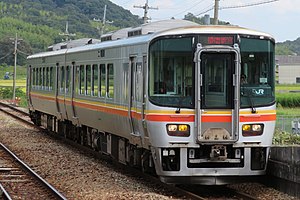| KiHa 122/127 series | |
|---|---|
 KiHa 127 series 2-car DMU near Oichi Station in September 2019 KiHa 127 series 2-car DMU near Oichi Station in September 2019 | |
| Manufacturer | Niigata Transys |
| Constructed | 2008–2009 |
| Entered service | 2009 |
| Number built |
|
| Number in service | 19 vehicles |
| Formation |
|
| Capacity |
|
| Operators | JR-West |
| Depots | Himeji |
| Lines served | K Kishin Line |
| Specifications | |
| Car body construction | Stainless steel |
| Car length |
|
| Width | 2,900 mm (9 ft 6 in) |
| Height | 4,040 mm (13 ft 3 in) |
| Doors | Two pairs per side |
| Maximum speed | 100 km/h (62 mph) |
| Prime mover(s) | SA6D140HE-2 |
| Power output | Per engine: 331 kW (444 hp) at 2,100 rpm |
| Transmission | Hydraulic |
| HVAC | WAU707 ×2 |
| Bogies | WDT65 (driving), WTR248 (trailing) |
| Braking system(s) | Engine brake, electronically controlled pneumatic brakes |
| Safety system(s) | ATS-SW |
| Track gauge | 1,067 mm (3 ft 6 in) |
The KiHa 122 series (キハ122系, Kiha-122-kei) and KiHa 127 series (キハ127系, Kiha-127-kei) are diesel multiple unit (DMU) train types operated by West Japan Railway Company (JR-West) on the Kishin Line between Himeji and Kōzuki. A total of 19 cars have been delivered, formed as seven single-car KiHa 122 series units and six two-car KiHa 127 series units. Test-running commenced in late September 2008, with the units entering revenue-earning service from the start of the revised timetable on 14 March 2009.
Exterior
The body design features improved crash resistance, based on the 223 series electric multiple unit design. The cars use environmentally-friendly diesel engines with reduced NOx and particulate emissions.
Externally, the units are finished in unpainted metal with thin yellow and red waistline stripes.
Interior
Internally, the cars feature flip-over reversible seating arranged 2+1 abreast. Toilets in both types of train are wheelchair-accessible, and the step between the passenger compartment and station platform has been eliminated.
-
 KiHa 127 interior
KiHa 127 interior
-
 KiHa 127 forward view showing LED fare board for wanman driver-only operation
KiHa 127 forward view showing LED fare board for wanman driver-only operation
-
 KiHa 127 toilet
KiHa 127 toilet
Formations
The KiHa 122 single-car units and KiHa 127 two-car units are formed as follows.
KiHa 122 series (single-car unit)
The KiHa 122 series uses a diesel engine with a small lithium-ion battery (18 kWh) that is used to power auxiliary machines in the train.

| Designation | cMc |
|---|---|
| Numbering | KiHa 122-0 |
| Weight (t) | 40.5 |
| Capacity Total/seated |
113/33 |
(Equipped with toilet)
KiHa 127 series (2-car units)
| Designation | Mc1 | Mc2 |
|---|---|---|
| Numbering | KiHa 127-0 | KiHa 127-1000 |
| Weight (t) | 38.5 | 37.5 |
| Capacity Total/seated |
130/41 | 138/51 |
(KiHa 127-0 is equipped with a toilet.)
Derivatives
- ET122, single-car DMUs for use on the third-sector Echigo Tokimeki Railway Nihonkai Hisui Line since March 2015
References
- キハ127+キハ122,網干へ回送 [KiHa 127 & 122 moved to Aboshi]. Japan Railfan Magazine Online (in Japanese). Japan: Koyusha Co., Ltd. 2 October 2008. Retrieved 14 March 2012.
- ^ JR西日本 キハ122形・キハ127形を姫新線に導入 [JR-West to introduce KiHa122/127 on Kishin Line]. Tetsudō Daiya Jōhō magazine. Vol. 37, no. 294. Japan: Kōtsū Shimbun. September 2008. p. 70.
- ^ キハ122・127系 気動車 [KiHa 122/127 series DMU]. Japan Railfan Magazine. Vol. 49, no. 573. Japan: Kōyūsha Co., Ltd. January 2009. pp. 68–72.
- ^ キハ127+キハ122が試運転 [KiHa 125 + KiHa 122 Test run]. Japan Railfan Magazine Online (in Japanese). Japan: Koyusha Co., Ltd. 22 September 2008. Retrieved 14 March 2012.
- Yomiuri Shimbun: 新型高速ディーゼル登場姫新線 (15 March 2009). Retrieved on 18 March 2009 (in Japanese)
- ^ キハ122、127系気動車の新製投入について [Introduction of new KiHa 122/127 series diesel cars]. Press Release (in Japanese). Japan: West Japan Railway Company. 26 August 2008. Archived from the original on 15 January 2009. Retrieved 14 March 2012.
- Nishiwaki, Kōji (January 2011). JR各社の新世代気動車の現況 JR西日本キハ122・127形 [The Current State of Modern JR DMUs - JR-West KiHa 122/127]. Japan Railfan Magazine. Vol. 51, no. 597. Japan: Kōyūsha Co., Ltd. pp. 108–110.
- Yamamoto, T. (2017). "Trends and Recent Studies on Hybrid Railway Vehicles". Quarterly Report of RTRI. 58 (1): 1–5. doi:10.2219/rtriqr.58.1_1.
External links
- KiHa 122/127 series press release (JR-West) (in Japanese)
- JR-West KiHa 122/127 series (Japan Railfan Magazine) (in Japanese)
| Current / active |
| ||||||||||||||||||||||||||||||||||
|---|---|---|---|---|---|---|---|---|---|---|---|---|---|---|---|---|---|---|---|---|---|---|---|---|---|---|---|---|---|---|---|---|---|---|---|
| Retired / withdrawn |
| ||||||||||||||||||||||||||||||||||
